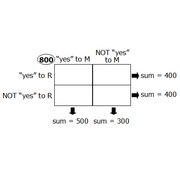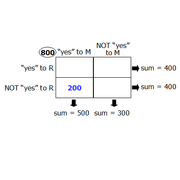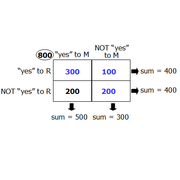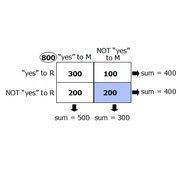----------------YES---------NO----UNSURE
Subject M----500--------200-----100
Subject R----400--------100-----300
A total of 800 students were asked whether they found two subjects, M and R, interesting. Each answer was either "yes" or "no" or "unsure", and the numbers of students who gave these answers are listed in the table above. If 200 students answered "yes" only for subject M, how many of the students did not answer "yes" for either subject?
A. 100
B. 200
C. 300
D. 400
E. 500
Use a Venn diagram to represent all of the YES voters:

The TOTAL who voted YES for M = 500.
The number who voted YES for ONLY M = 200.
Thus, the number who voted YES for BOTH M AND R = 300.
Since the TOTAL number who voted YES for R=400, and 300 of these people voted YES for BOTH M AND R, the number who voted YES for ONLY R = 400-300 = 100.
Adding the values in the Venn diagram, we get:
Total number of YES voters = 200+300+100 = 600.
Since the total number of voters = 800, and the total number of YES voters = 600, the number who did NOT vote YES = 800-600 = 200.
The correct answer is
B.
Private tutor exclusively for the GMAT and GRE, with over 20 years of experience.
Followed here and elsewhere by over 1900 test-takers.
I have worked with students based in the US, Australia, Taiwan, China, Tajikistan, Kuwait, Saudi Arabia -- a long list of countries.
My students have been admitted to HBS, CBS, Tuck, Yale, Stern, Fuqua -- a long list of top programs.
As a tutor, I don't simply teach you how I would approach problems.
I unlock the best way for YOU to solve problems.
For more information, please email me (Mitch Hunt) at
[email protected].
Student Review #1
Student Review #2
Student Review #3

























